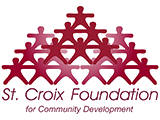Over the last ten years, the St. Croix Foundation has worked inside classrooms, side-by-side with teachers. We have sat in on teacher team meetings, lunched with teachers, and walked the same hallways. We traveled with them to educational conferences, wept with them through trying times and celebrated in times of great triumph.
What we learned is that many of our teachers spend each day in isolation, dealing with disadvantaged, oftentimes ill-mannered students (and parents), not to mention a bureaucracy that can de-motivate the most energized professional. In actuality, many of the educators we have met have a real passion for educating children. They are unquestionably the single greatest assets in our public schools because they are the one constant. While administrators and students come and go, sometimes in rapid succession, teachers are the long-term caretakers of each school’s history and culture and the foundation of our children’s academic achievement.
Today, in the 21st century, a lot is expected of teachers. They must be adept at using a variety of new technologies; keep up with popular culture; understand changing language and ideals; and spend many personal hours preparing new lessons and researching new teaching methodologies. They must also contend with the pressures of a bad economy, “hyperactive” students, and a lack of meaningful support from their superiors and the community at-large, all the while being forced to be both parent and teacher for many students.
As President Obama stated in one of his first speeches on education, “It’s time to start rewarding good teachers, and stop making excuses for bad ones.” We believe that in order for our community to ‘walk the talk’ about the importance of our children, our teachers—our good teachers—must be elevated to a higher stature and prominence matched with higher pay that is unequivocally married to high expectations.
The Impact of Bad Teachers
For the same reasons they are assets, our teachers can be potential liabilities because, on the flip side of our teachers’ tremendous contributions, there are also some critical deficiencies that require the diligent focus and attention of every public education stakeholder. From the very beginning of our on-the-ground work in schools, the Foundation began to observe some noteworthy performance patterns, including: Use of the Union Contract as a guard against new ideas or personal accountability; Low expectations for themselves, administrators, and students; Resistance to the use of technology; A propensity for blaming “others” (administrators, parents, funding shortages, and etc.) for poor student performance; And, a sometimes shocking lack of professionalism and respect for authority.
Undoubtedly, ineffective teachers are a huge part of the challenge that lies before every effort to improve the quality of public schools nationwide. In reality, states throughout the country are afflicted with the same powerlessness and costliness that our local district administrators experience when attempting to create a greater density of good teachers while also removing bad teachers. In New York, hearings for a dismissal of just one incompetent teacher can extend for 830 days, over two years, and cost taxpayers $313,000.
The arduous task of filtering underperforming teachers from the system is inextricably tied to the greater challenge of building a sufficient pool of high-quality teachers, particularly here in the Territory. In truth, the seldom discussed reality in our school system is that many of our teachers are homegrown products of our own public education system, moving straight through the system from Kindergarten to 12th grade, to the University of the Virgin Islands (UVI), and then right back into our classrooms. To fully understand the challenge, consider that in 2013 88% of UVI’s freshmen were required to take remedial courses in English because they were not college-ready after graduation.
Luckily, there are proven models for attracting, training, and retaining effective teachers. In Finland, they decided that only the best and the brightest will teach their children: 100% of new teachers graduate in the top third of their high school class. In contrast, a math teacher in Oklahoma today is required to receive a score of at least 19 on the ACT test to be admitted to a college of education. At the time, the national average was 20.6.
We know we have extraordinary, talented, passionate teachers in the Virgin Islands, because we meet them every day. And, we know that the District is in the middle of implementing a new evaluation system, for which we applaud them. But, this election season, let’s ask our political candidates how they plan to legislate even more comprehensive reforms that raise the bar, prepare, support, and compensate our teachers like the professional, highly qualified educators that all our children deserve.
This editorial is part of the Foundation’s Education First series. For more information, call 773.9898.
Sources and Links:
President Barack Obama:
• Remarks by the President to the Hispanic Chamber of Commerce on a Complete and Competitive American Education, March 10, 2009
New York Teacher Dismissal Data:
• https://www.nydailynews.com/opinion/firing-teachers-mission-impossible-article-1.1615003
February 17, 2014
US Virgin Islands Remedial English Classes Data:
• Literacy Across UVI, UVI Voice, University of the Virgin Islands, September 19, 2013
Finland and the United States:
• Ripley, Amanda. The Smartest Kids in the World and How They Got That Way. Simon and
Schuster. 2013 (92-93).
